Tim Beeby
"Unsigned isn't a manifesto or a business model,
it's allowed to be illogical and contradictory"
A Debate with Wolfgang Ullrich
Is it the signature that turns a piece of work into art? Galerie Vayhinger based in Singen, Germany, and the artist Tim Beeby have ventured an experiment in Berlin, Vienna, and Cologne. The idea behind "Unsigned Untitled Undated," as Helena Vayhinger explains, is quite simple: "'Unsigned' offers visitors to the exhibition the opportunity of taking a work from Tim Beeby's series 'Inks' free of charge." Alternatively they can have the canvas signed, titled, and dated, and acquire them at prices starting at €1400. All the signed canvases will be digitally catalogued, whilst the unsigned ones remain undocumented. Such a strategy may be equally surprising to both layperson and expert. Below, the Leipzig-based art historian Wolfgang Ullrich enters into a debate with Tim Beeby, currently living and working in Essen, Germany. Swinging between astonishment and disbelief, he nevertheless doggedly digs deeper, such as when he asks, "Aren't you proposing from the outset that a person who is only taking an unsigned canvas is going to feel some sense of deficiency? That this 'for free' will inevitably be perceived as the bargain option, which will always be inferior in comparison to an official purchase of a work? So that consequently the bargain hunter is unable to have the same aesthetic experience as the collector?" The discussion, which was carried out by email, concludes with the artist optimistically speculating, "But what if…?"
FROM THE PRACTICAL TO THE CONCEPTUAL
Wolfgang Ullrich: Tim Beeby, your project "Unsigned Untitled Undated" is almost a kind of experiment that is testing the art audience and its reactions to a rather shrewdly conceived scenario commandeering the logic of the art market. Was there a key experience that led you to such a concept?
Tim Beeby: "Unsigned Untitled Undated" offers visitors a choice of taking an unsigned, untitled, and undated canvas away with them free of charge, or selecting a canvas to be signed, titled, and dated, and acquire it at the standard market price. There is no difference between the signed and unsigned works in terms of the materials used and aesthetic value.
The concept developed out of my series "Inks," which has been ongoing since 2012. The Inks are processed-based works involving the fundamental phenomenon of the 'flow,' or as Manuel De Landa elaborates in his book A Thousand Years of Nonlinear History, "flows of lava, biomass, genes, memes, norms, money… are the source of just about every stable structure that we cherish and value."
The "Inks" series soon developed into multi-canvas pieces. One of the first was an installation covering the whole of a studio wall. Having stretched the canvases in different sizes and hung the blank canvases on the wall – perhaps a total of twenty-five – and having applied 'inks' on three or four, I decided the piece was finished. The problem then was what I should do with the work afterwards. There was no immediate opportunity of exhibiting it. I could either go on to use the blank canvases for new work or store the whole as finished work. I decided on the latter. But it seemed absurd to wrap empty canvases in plastic and just put them in my storage space, which is also rather small. And how would I know in the future which empty canvases belonged to which work? I decided I needed to sign them for purposes of identification, and so photographically documented the installation, signed, titled and dated all the canvases, wrapped them all up, and put them in the storage space.
The result was that the work not only took up a lot of space, but I now also had to buy more canvas and stretchers. I think I decided at that moment that the canvases should be left unsigned unless someone wanted to buy them. But also, if I could somehow give away the work unsigned, I could also make space for new work. It was about the burden of administrating my own work.
Dealing with a practical problem led to a conceptual idea. But in the end "Unsigned" wasn't comprised of work from my storage space but new work made specifically, because it became important that the project possessed an aesthetic unity. Each presentation always began with one hundred canvases.
W. U.: You carried out your experiment in three different places. What were the results? How many canvases did people take, how many were bought?
T. B.: The project has taken place in Berlin, Vienna, and Cologne for four days respectively. Each time, an average of 30 to 40 works on canvas were taken free of charge, and a total of six were sold.
The canvases that were sold were photographically documented and will be digitally catalogued, a certificate of authenticity was also given to the buyer. These will be the only ones that I recognize as my own work. But perhaps Unsigned Untitled Undated will only really be completed as a conceptual piece when someone attempts to sell an unsigned canvas through an auction house.
W. U.: Could we say that on the one hand there are consumers of art who choose a work with regard to whether it matches their home decor – happy that they have unexpectedly acquired a piece of art for nothing? Whilst others, the ones who've paid, are real collectors for whom the piece would be worth nothing, as long as it is not specifically declared as art?
T. B.: Duchamp once asked, "Can works be made which are not 'of art'?" (Peut-on faire des oeuvres qui ne soient pas «d'art»?) If some visitors regard the unsigned works as something that is not art, then the answer to Duchamp's question might have been found. But in truth, I see it the other way round: the essential point for me is that the unsigned works are not a commodity; they are only art, nothing else.
A clear division between so-called consumers of art, who were looking to decorate their home with a free piece of work, and collectors who did not want to eschew, for strategic reasons, the artist's signature wasn't apparent. Basically, everyone reacted differently. In Cologne, for example, there were several visitors who thought that the best way to do justice to the concept was to hang both a signed and an unsigned work next to each other. Which of course was one option, since the purchasing of a signed work did not exclude the possibility of also taking an unsigned work free of charge.
With regard to taking works free of charge, the only restriction was "one canvas per person." Some people were very modest, so there were couples who could have taken two but decided on just a single canvas. Others, in contrast, began telephoning around to recruit as many relatives and friends as they could, so as to be able to leave the exhibition space with the maximum number of canvases. I'm not judgmental of any of the responses, and all the attitudes on display were, for me, a part of the work in its social dimension.
ONLY ART, NOTHING ELSE?
W. U.: You say that the unsigned canvases are "only art" – and not commodities. But what, in your opinion, makes them art? Normally, it is – at least in the modern era – a signature or other certification that identifies something as art. Historically it has been the mastery of a specific skill or iconography that elevated particular works above others and transformed them into art. But what would this be in the case of the 'unsigned' canvases?
T. B.: It's the convention in western art of the stretched canvas, which enjoys a unique status – one that distinguishes it from all other materials used for art – in that it has just one imaginable purpose, that is as a support for painting. If it was on paper it wouldn't mean it could be automatically identified as art, it could just as easily be a pencil sketch of a plan or map, a snapshot, a poster, and so on. The same would also be true for three-dimensional objects using conventional art materials such as bronze or marble. Instead of art they could also be a machine part or a tile. These examples aren't things that could irrefutably be identified as art without the artist's signature. A stretched canvas on the other hand will always possess the aura of art, also if it's unsigned or even if it's blank.
DISBELIEF AND BREAKING A TABOO
W. U.: How would the circumstances be different, in your opinion, if the project involved more elaborate pieces that had required weeks of painstaking work? Wouldn't people have been more conflicted in taking such a work for free? There would be the dilemma of either feeling guilty for having accepted such a generous gift, or – if you didn't want to accept it – of having paid quite a large sum of money for something which you could've had for nothing. For many, the situation would be the cause of considerable inner turmoil. And you as an artist would be in the position of staging it as a grand gesture, even a kind of potlatch. What a sublime gesture it would be that you wouldn't seem to care whether people paid an appropriate amount or simply took works which you'd put so much effort into!
T. B.: The scenario you describe, involving more, so-called, elaborate works, is exactly what happened in the exhibition space! The concept really succeeded in drawing visitors in and left virtually no one unmoved. Everyone felt obliged to approach it seriously and come to their own ethical decision.
The project debuted in Berlin, and before the opening of the exhibition it was impossible to predict what exactly would happen. Would visitors interact with the work and actually take a piece of work away with them, let alone buy one? One of the first visitors was Gunnar Lützow, who would later write an article about the concept for the German broadsheet DIE ZEIT (I was unaware of this at the time). His visit was described by Siegmund Kopitzki, whose article for Südkurier, another newspaper, was the first to appear about the project: "The young man, one of the first visitors […] takes his time. He strolls through the gallery space several times, taking a look here and there, sometimes picking up a canvas leaning against the wall, apparently unable to decide. Finally he finds something; after consulting with the artist, he grabs a large piece of work, ink on canvas, packs it in two red plastic carrier bags, and bids the artist farewell, without having left any remuneration or contact details."
That was the point where everybody sort of gasped, a moment of disbelief, a rather shocking “did that really happen” moment for everyone present. A taboo had been broken.
I can understand how the idea contained in your question – that it may be easier to take a work that involves less work – could have come about. But in the actual exhibition space such thoughts didn't seem to be an issue. The visitors were confronted with works that had obviously been meticulously produced, installed in stacks that had both a clinical and sculptural presence, creating an austerely minimal atmosphere that wasn't to be easily violated.
The opportunity of taking an Ink free of charge was not subject to any conditions whatsoever. You could buy one – perhaps as an investment – but that made no difference from an aesthetic or artistic point of view.
A SENSE OF DEFICENCY?
W. U.: I have some doubts concerning your last sentence. Do you really think that it makes no difference to the way a work is perceived whether someone is looking at a piece of work that they have simply taken from one of your exhibitions, or at one for which a four-figure sum has been paid? Aren't these two different forms of ownership? And doesn't it create a sense of luxury – in the sense the philosopher Lambert Wiesing defines it in his book of the same name – when money is spent on something that could've been had for free? Isn't it possible that someone who has paid for one of your works, whilst considering this to be an irrational act, would at the same time enjoy a feeling of independence, of being superior to reason? And wouldn't this result in a completely different perception of the work – that is, a different aesthetic quality – than if it had been obtained at no expense?
T. B.: I'm not sure in this case that the subjective perception you are addressing, and what I call aesthetic and artistic quality are the same thing. We are approaching the issue from two different directions. By way of illustration, I would like to cite the example of a collector in Cologne who bought a work and also took away a second unsigned canvas, with the intention of hanging them side by side, as she believed that this was the best way to do justice to the concept. Looking at the two canvases on her wall, which was the one that had been signed would remain imperceptible as we wouldn't be able to see their reverse sides. Any judgment entailing financial value would therefore be eliminated, and the only thing remaining would be their aesthetic appearance, which we would very probably perceive as being very similar, and it could likewise be assumed that the owner appreciates both of them equally.
W. U.: For a viewer who doesn't own a canvas it may be true that a purchased canvas and one taken for free possess the same aesthetic quality. And for the Cologne collector you mention, apparently only the two canvases together create a work of art. But what about other collectors who only bought a canvas, or visitors who just took one away with them? Maybe I can formulate it as follows: what reason would a collector have for buying a canvas, if they could've acquired it for nothing, if it wasn't for the specific experience of spending money, of taking possession – unless it was a patron who wanted to support you and the gallery? Or could the incentive to buy have been simply that the free works in your project have a purely negative connotation, as already indicated by the title? After all, everything that is traditionally connected to the purchasing of art, that is the signature, titling etc., has been eschewed. Aren't you entertaining, from the outset, the possibility that a person who is only taking an unsigned canvas is going to feel some sense of deficiency? That this 'for free' will inevitably be perceived as the bargain option, which will always be inferior in comparison to an official purchase of a work? So that consequently the bargain hunter is unable to have the same aesthetic experience as the collector?
T. B.: Of course we can only speculate about the motives of the buyers, but my feeling is that they were convinced to such an extent by the concept that they wanted to invest in it. I suppose this could be described as an experience of spending money. The argument of ownership, on the other hand, isn't one that could be deployed here, since the others are also owners.
But perhaps we should consider some issues around how both audiences and owners traditionally interact with works of art. The audience for art may look at a work of art and think about it; their options are limited to those of viewing and contemplation, whilst the latter also benefit from the experience of spending money and ownership, and as owners they are permitted to touch their property, and so their relationship to the work of art is also a haptic one.
Such an opposition between audience and owners is renegotiated by the 'Unsigned Untitled Undated' project; the relations are transformed. Since the experience of spending money is no longer a prerequisite, less financially fortunate visitors are now able to enter an area previously reserved for buyers of works of art. The owners of an unsigned canvas are now equally able to experience ownership, which however in this case is not bound to that of spending money, and they, too, benefit from a haptic relationship with the work they own. As a consequence, a new kind of interaction has been established that enables a new, more extensive, and deeper relation to the work of art.
As for the second part of your question, I think the negative connotation you attribute to the free works merely reveals the power of conventions and the limits of language. Even though we are aware that the convention of signing works of art has only existed since the Renaissance, we still consider it a 'natural given.' The limits of language emerge the moment we oppose convention. In verbally signaling our refusal or denial of a convention we are compelled to resort to a negative term, 'signed' being countered by using the prefix 'un.'
A PUNK ROCK MOMENT
W. U.: But then, couldn't you have just called your project "Liberated from Signature, Title, and Date," or simply "The Pure"? To signal that the traditional collector who buys something for money and insists on an administrative warranty, is a figure that is problematic for art? Or would such a message be going too far for you?
T. B.: Another good alternative could've been "Free Art" in its double meaning, but ultimately this would be mere sloganeering. Nevertheless, I do think the art world has long been ready for a "punk rock" moment, in that any critical potential is immediately lost in a situation when works are being exchanged for absurd sums. In order to resist the forces of a hyper-capitalist society it is not enough, as an artist, to make works about current social injustices. Rather, art in and of itself must be political.
"Unsigned" opens up a new way for art audiences to interact with art, whilst critically highlighting social inequalities that are likewise visible in the art world. The project functions in such a way that those with less financial resources are subsidized by the acquisitions of those who are more financially fortunate, it enables a kind of redistribution of wealth. In return, those who take a work for free, are directly involved in enacting a completely new art strategy, in breaking a taboo, which in turn could potentially lead to an increase in financial value of the works sold. Unsigned is a conceptual approach that is democratically and economically fairer.
W. U.: Let's return to the title of your project. So far we have talked about the fact that the works taken for free are not signed. But they are also 'untitled' and 'undated.' The former doesn't seem that unusual, in that many works of modern and contemporary art are designated 'untitled.' But 'undated' I find more striking, since the dating of art has been very important during the entire modern age, because it specifies when exactly an artist was active in relation to contemporaneous developments. It supports the idea of progress, and it was particularly important for the avant-gardes in terms of who was first to introduce any new innovation. In leaving the pieces you give away undated, you are, in addition to making them anonymous, also depriving them of any art historical timeframe, within which they could be considered meaningful.
T. B.: These are interesting considerations. I fully agree with you that for the historical avant-garde, when a great number of groundbreaking innovations were following one after the other, it was important to art historically classify who did what first.
But the crucial aspect for me is that the act of signing, titling, and dating prepares the work of art for appropriation by administrative systems. I think this became clear to me in the course of my work as a translator for art museums. I don't only translate catalogue texts but also lists of works, and this process of rendering works, frequently consisting of a wide range of materials, into a short sequence of words is, in my view, a means of bureaucratically taming them. On entering an institution, a work of art immediately becomes captured linguistically, and that perhaps at the expense of its original power.
AN UNSTABLE EQUILIBRIUM
W. U.: This would mean that the canvases which are taken free of charge, retain the original power of art, since they remain untamed, as it were. Doesn't that also mean their artistic value would then be higher than those works that are catalogued? And isn't it something of a paradox that you, as an artist, are relinquishing any claims to authorship in relation to exactly those works retaining the greatest artistic power? Wouldn't your line of thought even imply that any reference to an author will always interfere with the pure power of art?
T. B.: For me, the strength of this project is its essential contradictions. Whilst on the one hand it's a utopian project, in that art is being given away free of charge, on the other it also recognizes that there are people who want to invest in art and to sell it on. The signed and unsigned canvases don't exist in any kind of symmetrical or hierarchical relation to each other.
To return to your question concerning the anonymous aspect of the work, I can perhaps imagine a museum in the distant future somehow coming into possession of a work from Unsigned and being obliged to catalogue it along the lines of: "Artist unknown, western Europe, probably end of the 20th / beginning of the 21st century." I don't find such a prospect that bad at all. And isn't this the manner in which non-western 'artifacts' are catalogued by Western museums anyway?
W. U.: The likelihood of that ever happening has significantly declined as a result of our conversation. Its publication will mean that a wider audience will become aware of your concept and with that the anonymity disappears. In that sense, it might even be considered inconsistent that you even talk about your concept at all. Doing so creates a connection between the unsigned canvases and your name. And why then should the signature remain the decisive element?
T. B.: You're right, the publishing of an article or interview is also part of the process of taming a work of art. It enters the art historical record, and specific verbal interpretations and meanings then become attached to the work.
Whilst I haven't deliberately tried to conceal my name during the presentations of "Unsigned" to date, it wasn't made conspicuous in any large lettering either, and in particular it wasn't part of the wall text. It's very well possible that there were people who took an unsigned canvas without knowing my name, even though I spoke to virtually everyone and we shook hands to close the deal, so to speak. I was aware from the beginning that it would look rather strange if the project had been titled Tim Beeby: Unsigned Untitled Undated.
But I'd have to disagree about the signature. The signed and unsigned canvases orbit each other without ever achieving a stable equilibrium, rather their interrelations deepen the concept. Unsigned isn't a manifesto or a business model, it's allowed to be illogical and contradictory. It's merely asking the question: "But what if…?"
Tim Beeby: "Unsigned ist kein Manifest oder gar Geschäftsmodell, es darf unlogisch oder widersprüchlich sein. Ein Streitgespräch mit Wolfgang Ullrich," in: Paolo Bianchi (ed.). Staunen. Plädoyer für eine existenzielle Erlebensform, published as Vol. 259 of "Kunstforum International," Cologne 2019, pp. 126–135.
KUNSTFORUM International vol.259
Tim Beeby – A Debate with Wolfgang Ullrich
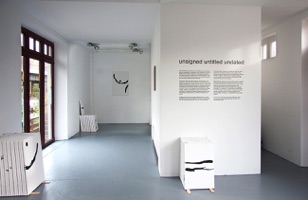
Tim Beeby, Unsigned Untitled Undated
Installation view Haus 1 Berlin, November 2017
Tim Beeby, Unsigned Untitled Undated
Installation view, studio September 2017
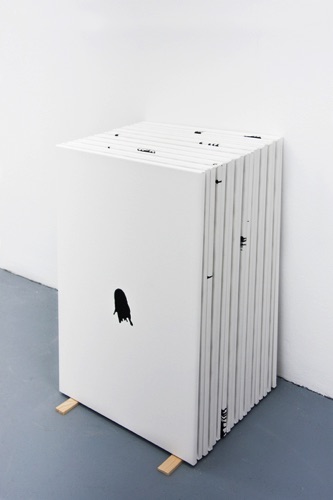
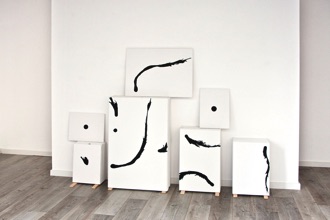
Tim Beeby, Unsigned Untitled Undated
Installation view Goltsteinstr. 49, Cologne, September 2018
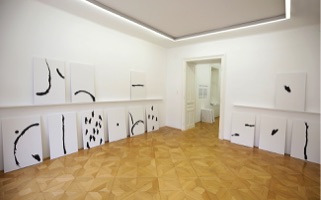
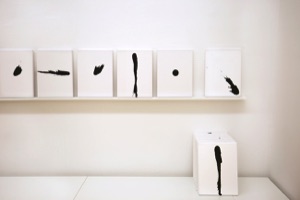
Tim Beeby, Unsigned Untitled Undated, installation view Galerie Vayhinger, Singen, hosted by galerie bechter kastowsky, Vienna, June 2018